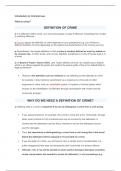Class notes
The best key to pass criminal law in university
- Course
- Institution
Studying Law gives students an understanding of the role of Law in today's society and raises their awareness of the rights and responsibilities of individuals. By learning about legal rules and how and why they apply to real life, students also develop their analytical ability, decision making,...
[Show more]



